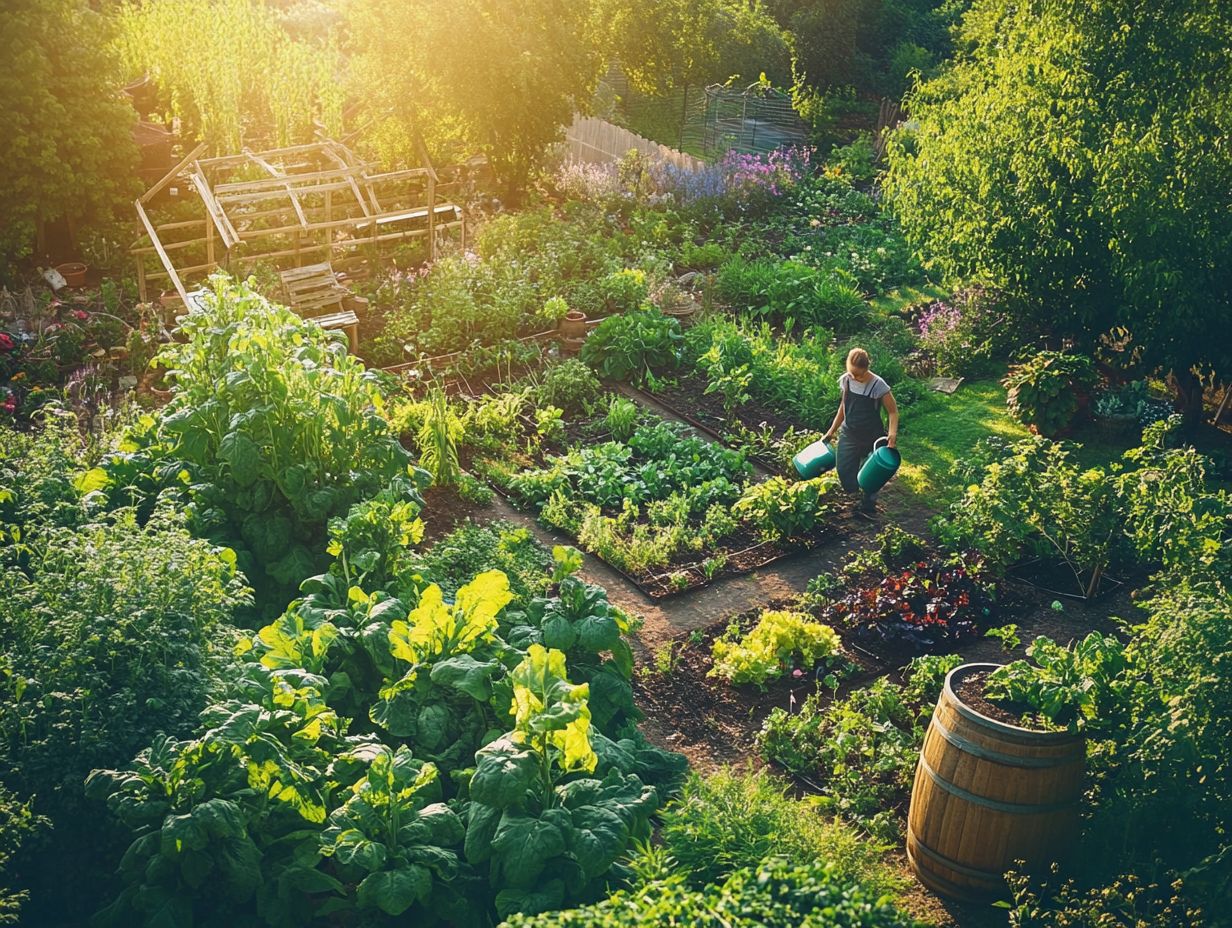How to Water Your Permaculture Garden Efficiently?
Permaculture gardening goes beyond sustainability; it creates a system that works in harmony with nature.
Efficient watering is crucial for a thriving permaculture garden. Mastering this skill not only boosts plant health but also conserves water and reduces your environmental footprint.
This article explores efficient watering strategies and their benefits. You ll learn practical methods to maintain a water-wise garden that flourishes with the ecosystem!
Contents
- Key Takeaways:
- Understanding Permaculture Gardening
- The Importance of Efficient Watering
- Factors Affecting Watering Efficiency
- Methods for Efficient Watering
- Tips for Maintaining Efficient Watering
- Frequently Asked Questions
- What is permaculture gardening and why is efficient watering important?
- What are the best methods for watering a permaculture garden efficiently?
- How often should a permaculture garden be watered?
- Can greywater be used for watering a permaculture garden?
- How can I conserve water while still ensuring my permaculture garden receives enough moisture?
- What are some signs that a permaculture garden is not being watered efficiently?
Key Takeaways:

- Permaculture gardening designs a self-sufficient garden that mimics nature while providing food.
- Efficient watering conserves water, promotes plant growth, and minimizes environmental impacts.
- Climate, soil, and plant choices affect the best watering methods for your garden.
Understanding Permaculture Gardening
Permaculture gardening is a holistic approach focusing on sustainability and ecological balance. By using permaculture principles, you can enhance plant variety while minimizing environmental impact.
This practice uses organic matter to create self-sustaining ecosystems. It improves soil health and promotes strong plant growth, especially in places like Bozeman and the Rocky Mountain West.
What is Permaculture Gardening?
Permaculture gardening combines farming techniques with ecological principles. It was developed in the 1970s by visionaries like Bill Mollison and David Holmgren.
At the heart of permaculture is observing nature and understanding how ecosystems work. This knowledge helps maximize productivity while keeping soil healthy and nurturing the connections among plants, animals, and microbes.
By focusing on plant variety, you create resilient environments. These gardens yield nutritious produce and foster a sense of responsibility towards the planet.
The Importance of Efficient Watering
Efficient watering is essential for a flourishing garden, especially in drought-prone areas like the Gallatin Valley. Effective water conservation greatly influences plant health and crop yield.
By installing suitable irrigation systems, you can optimize water usage and ensure your plants get the moisture they need. This not only enhances your gardening success but also supports sustainable practices that benefit the environment.
Benefits of Efficient Watering
Efficient watering does more than save water; it improves soil moisture, promotes healthy plants, and supports drought-tolerant species. These practices help in growing vegetables efficiently.
Using advanced methods like drip irrigation or rainwater harvesting can greatly increase crop yields. These techniques direct water to the roots, reducing evaporation and maximizing absorption, leading to healthier plants.
Embracing these strategies enhances your gardening experience and contributes to a more sustainable environment for all!
Impact on the Environment

Efficient watering practices have a profound impact on the environment. When you embrace these practices, you foster greater environmental awareness and promote eco-friendly methods.
These methods protect water resources and enhance soil health. By adopting water-efficient techniques, you significantly reduce runoff, a major contributor to water pollution and unhealthy ecosystems.
This careful approach conserves water. It also enriches the soil, making it healthier and more vibrant.
As a result, you contribute to the development of healthier ecosystems. This creates inviting habitats for wildlife and supports biodiversity.
By engaging in conservation efforts, you can help restore natural habitats and thrive in your community. This ensures local flora and fauna thrive while fostering a more resilient environment for future generations.
Factors Affecting Watering Efficiency
Several factors influence watering efficiency in your garden. Consider climate conditions, soil type, and the careful selection and placement of plants.
This is especially important in urban gardening, where space and resources, including garden equipment, can often be constrained.
Climate and Soil Conditions
Climate and soil conditions are vital when it comes to watering practices. Variations in temperature, precipitation, and soil moisture retention can significantly affect plant growth.
Understanding how different climates influence water needs is key to implementing effective irrigation systems and rainwater collection methods.
For instance, if you’re in an arid region, employing drip irrigation a method that delivers water directly to plant roots can help conserve moisture.
Areas with higher rainfall might benefit from rainwater harvesting techniques to optimize water use. Conducting soil assessments is essential for identifying moisture levels.
This knowledge allows you to tailor your watering strategies accordingly. By ensuring the right amount of water reaches your plants, you can promote healthier crops while conserving valuable resources.
Plant Selection and Placement
Selecting the right plants and positioning them thoughtfully in your garden is crucial for maximizing watering efficiency. Opt for drought-tolerant varieties that thrive in your local conditions.
Delving into the intricate network of plant roots will significantly enhance your garden’s overall health. These roots anchor your plants and play a vital role in absorbing moisture and nutrients from the soil.
By recognizing the different water needs of various species, you can establish a watering frequency that ensures each plant flourishes.
Consider grouping plants with similar hydration requirements to minimize water waste while enhancing the aesthetic appeal of your garden design.
This holistic approach not only conserves water but also fosters a vibrant environment that supports biodiversity.
Methods for Efficient Watering
Implementing efficient watering methods is crucial for optimizing water use in your garden. Techniques such as drip irrigation and rainwater harvesting are invaluable in promoting water-wise gardening practices.
By adopting these strategies, you not only conserve water but also enhance the overall health of your plants. This ensures a flourishing garden that respects our precious resources.
Act now to maximize your garden’s potential!
Drip Irrigation Systems

Drip irrigation systems stand as one of the most water-efficient methods for delivering moisture directly to the root zones of your plants. This significantly enhances soil moisture retention and promotes healthier growth.
This innovative approach minimizes water wastage by ensuring that only the precise amount of water is supplied. This makes it especially advantageous in urban gardening, where space and resources may be constrained. Using a network of tubes, emitters, and valves allows you to customize the system to meet the specific needs of various plants, ensuring optimal growth while conserving your precious water resources.
Not only does this method maintain ideal moisture levels, but it also curbs weed growth. Water is directed right to the plants, leaving the surrounding soil dry. This targeted application supports sustainable practices, making it an excellent choice for both home gardeners and larger urban agricultural projects.
Rainwater Harvesting Techniques
Rainwater harvesting techniques, such as using rain barrels, are eco-friendly practices that empower you to harness natural resources while conserving city water.
Incorporating rain gardens can enhance soil moisture and reduce runoff, ultimately promoting healthier ecosystems. Embracing these sustainable gardening methods not only reduces the effects of urbanization but also plays a vital role in protecting local water quality.
You ll love discovering more benefits by using specialized garden equipment designed for efficient irrigation. By actively participating in conservation initiatives, you cultivate a more resilient garden and contribute positively to the environment around you.
Tips for Maintaining Efficient Watering
To maintain efficient watering practices, you ll need to blend regular assessments with informed garden maintenance. Embracing conservation initiatives will further enhance your commitment to sustainable gardening, ensuring that your efforts are both effective and environmentally responsible.
Conserving Water
Conserving water is essential for efficient gardening. There are various water-saving techniques you can employ to enhance moisture retention in your soil and optimize plant health.
Among these strategies, mulching stands out as a straightforward yet powerful method. By applying a layer of organic material, like straw or wood chips, you can significantly reduce evaporation rates while boosting soil health. Utilizing compost tea, a nutrient-rich liquid made from compost, also aids in moisture retention and creates an ideal environment for your plants to thrive.
As an urban gardener, you can particularly benefit from these methods. They allow for sustainable practices that combat the often dry conditions of city landscapes. By adopting these techniques, whether you’re a seasoned pro or just starting out, you can cultivate a lush, productive garden while making a meaningful contribution to water conservation.
Regular Maintenance and Adjustments
Regular maintenance and thoughtful adjustments to your watering frequency are essential for adapting to shifting environmental conditions and ensuring optimal soil health.
By consistently monitoring moisture levels in your soil, you’ll be able to determine the right moments to deploy watering tools like drip irrigation systems or sprinklers. Observing your plants growth patterns will offer invaluable insights into their specific needs.
A reliable watering guide can assist you in figuring out the appropriate quantities and timings that align perfectly with your garden’s unique requirements. Utilizing garden equipment designed for efficient watering not only conserves resources but also encourages healthier plant growth, ultimately leading to a thriving and sustainable garden environment.
Frequently Asked Questions

What is permaculture gardening and why is efficient watering important?
Permaculture gardening is a sustainable way to farm and garden. It works with natural ecosystems. Efficient watering conserves resources and reduces waste. It also provides the moisture plants need to thrive.
What are the best methods for watering a permaculture garden efficiently?
Effective ways to water a permaculture garden include drip irrigation and using mulch to retain moisture. Collecting rainwater is another great method. These techniques reduce waste and provide the right moisture for your plants.
How often should a permaculture garden be watered?
How often you water a permaculture garden depends on the climate, soil type, and plant needs. It’s best to water deeply once or twice a week to promote deep root growth and reduce evaporation.
Can greywater be used for watering a permaculture garden?
Yes, you can use greywater from sinks, showers, and laundry for your garden. Just make sure to use eco-friendly and biodegradable products to protect the plants and soil.
How can I conserve water while still ensuring my permaculture garden receives enough moisture?
To save water, consider a rainwater harvesting system. Collect rainwater in barrels or tanks for irrigation. Choosing drought-resistant plants and using mulch also cuts down on water needs.
What are some signs that a permaculture garden is not being watered efficiently?
Look for signs that your garden isn t getting enough water. Wilting or yellowing plants, excessive runoff, and dry soil indicate problems. Make sure to regularly check soil moisture and adjust your watering methods as needed.






